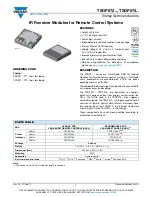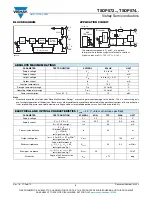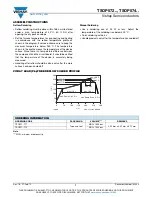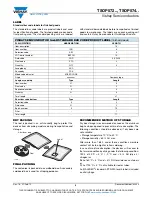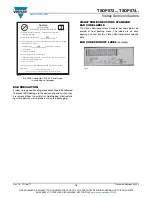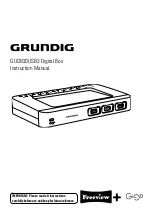
TSOP572.., TSOP574..
www.vishay.com
Vishay Semiconductors
Rev. 1.8, 27-Feb-15
5
Document Number: 82434
THIS DOCUMENT IS SUBJECT TO CHANGE WITHOUT NOTICE. THE PRODUCTS DESCRIBED HEREIN AND THIS DOCUMENT
ARE SUBJECT TO SPECIFIC DISCLAIMERS, SET FORTH AT
www.vishay.com/doc?91000
SUITABLE DATA FORMAT
The TSOP572.., TSOP574.. series is designed to suppress
spurious output pulses due to noise or disturbance signals.
The devices can distinguish data signals from noise due to
differences in frequency, burst length, and envelope duty
cycle. The data signal should be close to the device’s
band-pass center frequency (e.g. 38 kHz) and fulfill the
conditions in the table below.
When a data signal is applied to the TSOP572.., TSOP574..
in the presence of a disturbance, the sensitivity of the
receiver is automatically reduced by the AGC to insure that
no spurious pulses are present at the receiver’s output.
Some examples which are suppressed are:
• DC light (e.g. from tungsten bulbs sunlight)
• Continuous signals at any frequency
• Strongly or weakly modulated patterns from fluorescent
lamps with electronic ballasts (see figure 12 or figure 13)
Fig. 13 - IR Signal from Fluorescent Lamp
with Low Modulation
Fig. 14 - IR Signal from Fluorescent Lamp
with High Modulation
Notes
• For data formats with short bursts please see the datasheet for TSOP573..
• Best choice of AGC for some popular IR-codes:
TSOP57436: RC-5, RC-6, Panasonic;
TSOP57438: NEC, Sharp, r-step;
TSOP57456: r-step, Thomson RCA
0
10
15
20
Time (ms)
16920
IR Signal
5
0
10
15
20
Time (ms)
16921
IR Signal
5
TSOP572..
TSOP574..
Minimum burst length
10 cycles/burst
10 cycles/burst
After each burst of length
a minimum gap time is required of
10 to 70 cycles
≥
10 cycles
10 to 42 cycles
≥
10 cycles
For bursts greater than
a minimum gap time in the data stream is needed of
70 cycles
> 4 x burst length
42 cycles
> 10 x burst length
Maximum number of continuous short bursts/second
800
1300
NEC code
yes
preferred
RC5/RC6 code
yes
preferred
Thomson 56 kHz code
yes
preferred
Suppression of interference from fluorescent lamps
Most common disturbance
patterns are suppressed
Even extreme disturbance
patterns are suppressed

